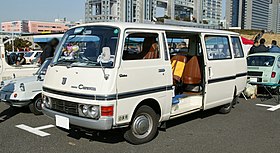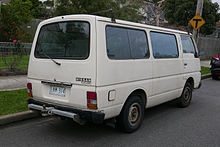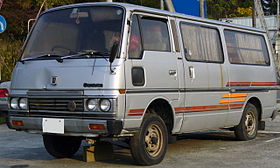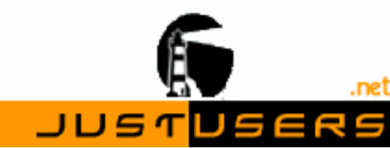Nissan Caravan From Wikipedia, the free encyclopedia For other makes with the same model name, see Caravan (disambiguation) § Automobile models. The Nissan Caravan is a light commercial van designed for use as a fleet vehicle or cargo van and manufactured by Nissan since 1973. Between 1976 and 1997, a rebadged version of the Caravan sold as the Nissan Homy, which was introduced as an independent model in 1965. Outside Japan, the Caravan was also sold as either the Nissan Urvan or Nissan King Van, or earlier with Datsun badging. All generations use a cabover approach due to Japanese Government dimension regulations that annually tax larger vehicles, and the cabover approach maximizes interior space while remaining within defined exterior dimensions. Prior to 1973, the Caravan's twin, the Homy had been offered as a standalone generation from 1965 until 1976. The Homy was built and sold by the Prince Motor Company before the merger of Nissan in 1965 and the Homy was the first vehicle to be acquired by Nissan. After the merger in August 1966, because Nissan didn't have a large passenger platform, the Prince Homy was "badge engineered" as the Caravan, and the brand name was changed from Prince to Nissan. The merger was complete by 1970. It shared a chassis with the Prince Homer, a medium-duty cabover pickup truck. The second generation Homy of 1976, was marketed as a twin to the 1973-era Nissan Caravan, sold at the Nissan Prince Store dealerships, while the Caravan was exclusive to Nissan Bluebird Store locations. The first generation series B640 which was changed to Nissan series T20 was built from 1965 to 1976, the second generation E20 was built from 1976 to 1980, and the third generation E23 was built from 1980 to 1986. The final generation E24 was built from 1986 to 1999, and replaced by the Nissan Elgrand. Mechanically, the Nissan Caravan and the Nissan Homy were identical. Its traditional competitor from Toyota is the HiAce. Nissan's largest passenger van is the Nissan Civilian, introduced in 1959, and their smaller platform was the Nissan Vanette. Contents 1.
First generation (B640); (1965-1973) 2.
Second generation (E20, E21, E22); (1973-1980) 3.
Third generation (E23); (1980-1986) 4.
Fourth generation (E24); (1986-2001) 5.
Fifth generation (E25); (2001-2012) 6.
Sixth generation (NV350/E26); (2012-present) 7.
References 8.
External links First generation (B640); (1965 - 1973)
Caravan (B640)
The Prince Homy (B640) was the passenger van version of the Prince Homer light duty truck, and had a seating capacity of up to 15 people. In 1966 as the Prince-Nissan merger began, it was initially called the Nissan Homy Prince, sharing load carrying duties with the Prince Skyway, and Prince Gloria station wagons; the Prince name became a dealership network within the Nissan organization in 1970. The Nissan Homy received the T20 model code, and in 1972, the vehicle was reclassified as a commercial vehicle, in order to comply with the 1970 Japanese road traffic law. Nissan had integrated a previously built product called the Nissan Caball as a cabover truck and cargo van, but had replaced it with the Homy. From 1973 the Homy was also available rebadged as the Nissan Caravan, to fit Nissan's various dealer networks. First generation Nissan Prince Homy (Thailand), sold as Nissan Homer Overview Production October 1965 - February 1973 Body and chassis Body style 4/5 - door van
5 - door minivan (Homy) Powertrain Engine 1.6 L OHV I4 Dimensions Wheelbase 2,130 mm (83.9 in) Length 4,325 mm (170.3 in) Width 1,690 mm (66.5 in) Height 1,900 mm (74.8 in) Curb weight 1,190 kg (2,623.5 lb) Second generation (E20, E21, E22); (1973 - 1980)
The E20 series Caravan and Urvan van and minibus were manufactured from February 1973 with seating configurations for three, five, seven, and up to 10 passengers. It was exclusive in Japan to Nissan Bluebird Store, while its twin the Nissan Homy was exclusive to Nissan Prince Store locations. It was especially popular in Europe, and was again very popular with fire departments and as ambulances in certain countries. It had a somewhat difficult handling, as it was heavy to steer, and was not available with power steering. Also, the gear shifter was located at the floor and went all the way up to the height of the hand, and had a slight curve. The gear shifter was nearly 80 cm (2.6 ft) long, so it was somewhat clumsy to shift, but it came with five gears, unusual in Europe at that time.
It was delivered with a 1.5- and 2.0-liter petrol engines, as well as a 2.2-liter diesel unit. It was produced until replaced by the E23 Caravan in August 1980. In export markets the first and second generations were called Datsun Urvan, until the Nissan brand replaced it worldwide in 1983 and 1984. In 1978, Nissan added the smaller Vanette as the Caravan grew in dimensions and market positioning.
Nissan Homy
The second generation was essentially a cosmetic update with no major mechanical changes. The model code changed to E20.
Caravan (E20)

Overview
Also called Datsun Urvan
Nissan Homy
Production March 1973–July 1980
Body and chassis
Body style 3-door van
4-door van
4-door minivan (Homy)
Powertrain
Engine
1483 cc J15 I4 (SE20)
1982 cc H20 I4 (PE20)
2164 cc SD22 diesel I4 (RE20)
Dimensions
Wheelbase 2,350 mm (93 in)
Length 4,690 mm (185 in)[4]
Width 1,690 mm (67 in)
Height 1,905 mm (75.0 in)
Curb weight 1,425 kg (3,142 lb)
Third generation (E23); (1980 - 1986)
The second generation Nissan Urvan/Caravan, the E23 series, was introduced in August 1980.[6] As before, the Homy, sold through Prince dealerships, was its twin model, set apart by a different grille. The Cabstar and Homer shared much of the bodywork, with the main differences being the frontal treatment and a small side window mounted in the front doors of the Caravan/Homy. Engines were all carryover four-cylinders, ranging from the J16 and H20 pushrod items, via the overhead cam Z20S, and an upgraded SD22 diesel. The van versions were now designed to allow access to the loading area from the passenger compartment. Radial tires were optional. The diesel also benefitted from a new five-speed manual gearbox, while the new luxury GL version offered an optional "Nissanmatic" automatic transmission as well as power steering, comfortable rotating rear seats and air conditioning. In July 1981, a luxurious SGL "Silk Road" version was added.

At the 1981 Tokyo Motor Show, two concept Caravans designed to provide limousine-like accommodation for businessmen were shown, the Royal and Elgrand Royal Line. The Elgrand name was to be adopted for a series of luxurious minivans, beginning in 1997. In May 1982, the Caravan underwent a minor facelift, losing the ventilation window in the front doors, receiving a new dashboard and a new five-bearing SD23 diesel engine replacing the previous SD22.[6] Radial tires became standard for all but the cheapest versions. For more power, coach versions also became available with the turbocharged LD20T diesel. The luxurious "Silk Road" version, with seven captain seats, was only available with the LD20T. This engine passed the 1982 emissions standards for diesel cars. To meet the 1981 emissions standards for petrol cars, coach versions replaced the H20 engine with the new carbureted Z18S and 105 PS (77 kW) Z20S.

In April 1983 there was another light facelift, with SGL and GL versions receiving a new look with four square headlights.[6] An LWB DX ten-seater version was also added. In January 1985, six and nine-passenger van versions were added. Diesel versions received improved pre-heating systems and safety equipment was improved. Manual petrol versions were now all five-speed units. An eight-seater "SGL Silk Road Limited" also joined the lineup in May. In September 1986, the E23 was replaced by the third generation E24.[6]
Nissan Homy
The Homy and its Caravan twin received their first full model change since the Homy was introduced in 1965. The engine was the 2.0-liter inline-four LD20T turbo diesel. The TD23 inline-four was also available.
Caravan (E23)

Nissan Caravan (E23) LWB
Overview
Also called
Datsun Caravan/Urvan (until 1983)
Nissan Homy
Nissan Urvan
Yue Loong Homer (Taiwan)[5]
Production August 1980–July 1986
Body and chassis
Body style 3-door van
4-door van
4-door minivan (Homy)
Related Nissan Atlas
Nissan Cabstar
Powertrain
Engine
1.6 L J16 OHV I4
1.8 L Z18S I4
2.0 L H20 OHV I4
2.0 L Z20S I4
2.0 L LD20T turbodiesel I4
2.2 L SD22 diesel I4
2.3 L SD23 diesel I4
Dimensions
Wheelbase 2,350 mm (92.5 in)
Length 4,350 mm (171.3 in)
Width 1,690 mm (66.5 in)
Height 1,950 mm (76.8 in)
Curb weight 1,930 kg (4,254.9 lb)
Fourth generation (E24); (1986 - 2001)
The E24 version was built from 1986 until 2001 and underwent two major facelifts, in 1990 and 1995. In some Scandinavian markets, the E24 series was marketed as the "King Van", to tie it in with the popular "King Cab" version of Nissan's D21 pickup truck. Originally, petrol-equipped Caravans had the Z20 engine while commercial diesels had the 2.3-liter, naturally aspirated TD23 and the Coach (passenger version) the LD20T II turbodiesel. With the October 1990 facelift this was switched to the NA20S. At the same time, an intercooled version (TD27Ti) of the 2.7-liter turbodiesel replaced the TD27T in most applications. The facelift consisted of a new grille (not on the DX) and new larger taillights (excluding the DX and GL models).
In August 1995 there was another facelift, mostly consisting of another new grille. The TD27Ti was upgraded to the electronically controlled TD27ETi. The large QD32 four-cylinder diesel was added to automatic-equipped van models in 1996 and produced 100 PS (74 kW) from 3153 cc. In May 1997, commercial models were upgraded so as to match the changes already introduced on the Coach models. In June 1999, the passenger models (and Homy nameplate) were discontinued and the engine lineup changed: petrol options were now 2.0 and 2.4-liter Twin Cam engines from the KA series, while only the naturally aspirated QD32 diesel remained.
In Kenya, the Nissan E24 is still manufactured by the Kenya Vehicle Manufacturers in Thika as of 2016.[8]
Nissan Homy
The Homy received its second full model change in September 1986 and was given the 2.0-liter Z20 engine, as well as the LD20T turbodiesel. The model code was now E24. In October 1987, four-wheel drive was added to the 2.7-liter TD27 engine. In March 1988, the premium grade "GT Limousine" was offered with the VG30E alongside the 2.7-liter turbodiesel. Yearly grade changes continued for the rest of the generation, adding items like cruise control, digital speedometers, larger wheels, upgraded interior and upholstery. August 1995 saw the Homy rebadged and sold as the Isuzu Fargo, using the TD27ETi diesel engine. The Homy Coach was replaced by the Nissan Elgrand in 1997 when the Nissan Prince Store Japanese dealerships were renamed Nissan Red Stage and vehicle overlap was streamlined. The Homy badge, first used in 1965, remained in use for commercial models until it, too, was cancelled in June 1999 as the Homy/Caravan lineups were merged.
FAW Jiefang CA 6440
FAW Jiefang made a clone of the E24 known as the CA 6440.[9] Production started in 1994, having a Chrysler-based CA488 engine with a 5-speed manual transmission.[10] According to the "Regulations on Beijing Road Traffic Management" and the "Regulations on the Implementation of the Law of the People's Republic of China on the Prevention and Control of Air Pollution," such vehicles still in service are not allowed to enter Beijing after May 10, 2001 as part of an effort to combat air pollution.[11]
Caravan (E24)

Overview
Also called Nissan Homy
Nissan Urvan
Nissan Urvan Escapade
Nissan Urvan Shuttle
Nissan Caravan Homy
Isuzu Fargo
FAW Jiefang CA 6440
Production August 1986–present
August 1988–May 2015 (Philippines)[citation needed]
Assembly Kenya: Thika
Philippines: Makati (August 1988-October 2002)
Santa Rosa City, Laguna (November 2002-May 2015)
Body and chassis
Body style 3-door van
4-door van
4-door minivan (Homy)
Related FAW Jiefang CA 6440 (1994–2000)[7]
Powertrain
Engine
Petrol:
1952 cc Z20 I4
1998 cc NA20S I4
1998 cc KA20DE I4
2388 cc KA24DE I4
2960 cc VG30E V6
Diesel:
1952 cc LD20T II turbodiesel I4
2289 cc TD23 I4
2494 cc TD25 I4
2663 cc TD27 I4
2663 cc TD27T/Ti/ETi turbodiesel I4
3153 cc QD32 I4
Transmission 4/5-speed manual
4-speed automatic
Dimensions
Wheelbase 2,375–2,645 mm (93.5–104.1 in)
Length 4,420–5,100 mm (174.0–200.8 in)
Width 1,690 mm (66.5 in)
Height 1,950–2,395 mm (76.8–94.3 in)
Curb weight 1,930 kg (4,254.9 lb)
Fifth generation (E25); (2001 - 2012)
Nissan produced the E25 series from April 2001 to 2012. It was also sold as the Isuzu Como on the Japanese market, replacing the last generation Isuzu Fargo which was a rebadged version of the E24 Caravan. The New Zealand Urvan received a one-star rating on the ANCAP crash test.[13]
Mexico was the only North American country to receive the Nissan Caravan vans. 2010 was the last year for this generation in Mexico, as the US-built Nissan NV replaces it.[14]
Caravan (E25)

Nissan Caravan (pre-facelift)
Overview
Also called Nissan Urvan
Nissan Urvan Estate
Isuzu Como
Production May 2001-May 2012
April 2002-March 2014 (Philippines)[12]
Assembly Kanagawa, Japan
Zhongji Company, Luanda, Angola
Kuala Lumpur, Malaysia (TCMA)
Santa Rosa City, Philippines (UMC)
Body and chassis
Body style 3-door van
4-door van
Powertrain
Engine
Petrol:
2.0 L KA20DE I4
2.0 L QR20DE I4
2.4 L KA24DE I4
2.5 L QR25DE I4
Diesel:
3.0 L ZD30DD turbo I4
3.0 L ZD30DDTi I/C turbo I4
Transmission 5-speed manual
4-speed automatic
Dimensions
Wheelbase 2,715 mm (106.9 in)
Length Pre-facelift: 4,990 mm (196.5 in)
Facelift: 4,995 mm (196.7 in)
Width 1,690 mm (66.5 in)
1,990 mm (78.3 in)
Height 1,990 mm (78.3 in)
2,285 mm (90.0 in)
Chronology
Successor Nissan NV (Mexico)
Nissan NV350 Caravan (Japan)
Sixth generation (NV350/E26); (2012 - present)
At the 2011 Tokyo Motor Show, a replacement of the Nissan Caravan, called the NV350 Caravan was premiered. It went on sale this 15 June 2012 with diesel engine and super long body variants will went on sale beginning 13 July 2012, and the wide version model arrived in winter 2012. The new NV350 Caravan comes with the all new YD25DDTi engine with clean diesel technology. Most petrol engines take advantage of its fuel saving technology for class leading fuel economy, for example the QR20DE. Those engines achieved either a 10 or 5 percent improvement in fuel economy over Japan's 2015 fuel economy standard. The NV350 Caravan continues to be sold as the Isuzu Como on the Japanese market as well.[15]
In the Philippines, the NV350 Caravan (E26) was introduced on 11 June 2015 and known as the NV350 Urvan.[16] The new NV350 Urvan imported from Japan instead of being assembled locally. The NV350 in the Philippines has only five models:The super Base-grade 3-seater Hi-roof Cargo, The Base-line 18-seater VX, The Top Base-line 15-seater Shuttle, The Mid-line 12-seater Escapade and The High-End 10-seater Super Elite. In May 2017 the Base-Top-of-the-line NV350 Urvan Premium was launched. it comes with 15 Seater, it is available in 5-speed Manual and 5-speed Automatic Transmissions, being the first ever Urvan in the Philippines that comes with a standard automatic transmission. In March 2018 the High-Top-of-the-Line Urvan Premium S was launched, it comes in 8-Seater. it is also available in 5-speed Manual and Automatic Variants. It now features the Touchscreen-Display Audio System, Dashcam, Power Mirrors, and Captain Seats. This is the first ever Urvan in the Philippines that offers a Captain Seats.
On 11 September 2013, Mitsubishi Fuso Truck and Bus Corporation and Nissan Motor Co., Ltd reached a basic agreement regarding original equipment manufacturer supply of finished commercial vans for export, whereby Nissan would supply NV350 Urvans to be sold as Fuso Canter Van.[17] Two versions are offered, the van and microbus.[18][19]
NV350 Caravan (E26)

Overview
Also called Nissan NV350 Urvan
Nissan Impendulo
Isuzu Como
Mitsubishi Fuso Canter Van
Production June 2012–present
Assembly Japan: Kanda, Fukuoka, Kyushu (Nissan Shatai)
Thailand: Samut Prakan
Body and chassis
Body style 3-door van
4-door van
Powertrain
Engine
Petrol/CNG:
2.0 L QR20DE I4
2.5 L QR25DE I4
Diesel:
2.5 L YD25DDTi I/C turbo I4
Transmission 5-speed Automatic
5-speed Manual
Dimensions
Wheelbase SWB: 2,555 mm (100.6 in)
LWB: 2,940 mm (115.7 in)
Length SWB: 4,695 mm (184.8 in)
LWB: 5,080 mm (200.0 in)
Width 1,695 mm (66.7 in)
1,880 mm (74.0 in) (wide body)
Height Low roof: 1,990 mm (78.3 in)
High roof: 2,285 mm (90.0 in)


 :
: 











